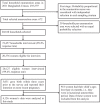Women's experience of unintended pregnancy and changes in contraceptive methods: evidence from a nationally representative survey
- PMID: 36050768
- PMCID: PMC9438238
- DOI: 10.1186/s12978-022-01492-w
Women's experience of unintended pregnancy and changes in contraceptive methods: evidence from a nationally representative survey
Abstract
Background: Ineffective or no use of contraception following an unintended pregnancy contributes to a subsequent unintended pregnancy. This study aimed to determine whether women's experiences of unintended pregnancies affect changing their contraceptive using patterns.
Methods: We analysed the 2017/2018 Bangladesh Demographic and Health Survey data. The contraceptive switching pattern was computed by comparing women's contraceptives using data before and after pregnancy. Women were categorised into the following three groups, depending on their patterns of contraceptive use before and after pregnancy: no change, if there were no change in contraceptive using pattern; switched to higher effective contraceptives, if changed from pre-pregnancy less effective contraceptives to post-pregnancy more effective contraceptives; switched to less effective contraceptives, if changed from pre-pregnancy more effective contraceptives to post-pregnancy less effective contraceptives. Women's intention in the most recent pregnancy was our primary explanatory variable, classified as wanted, mistimed and unwanted. Multinomial multilevel logistics regression was used to determine the association between women's intention in the most recent pregnancy and women's contraceptive methods switching patterns from before to after pregnancy.
Results: Around 20% of the most recent pregnancies that ended with a live birth were unintended at conception. No contraceptive use was reported by 37% of women before their pregnancies which decreased to 24% after pregnancies. Overall, around 54% of women who reported no contraceptive use before pregnancy used modern contraceptives after pregnancy. The rate was higher among women who experienced unwanted pregnancy (73.4%) than mistimed (58.8%) and wanted (53.4%) pregnancy. Experience of mistimed pregnancy was associated with a higher likelihood of no contraceptive change (aOR, 1.84, 95% CI 1.41-2.39) and switching to less effective contraceptives (aOR, 1.58, 95% CI 1.10-2.26) than switching to more effective contraceptives. However, unwanted pregnancy was not associated with any significant change in contraceptives use from before to after pregnancy.
Conclusion: Experience of unintended pregnancy did not change women's contraception using patterns, which indicates the risk of repeat unintended pregnancies and associated adverse consequences, including maternal and child morbidity and mortality. Policies to ensure access to and use of modern contraceptives among women facing unwanted or mistimed pregnancies are recommended.
Keywords: Bangladesh; Contraceptive; Mistimed pregnancy; Switching patterns of contraception; Unintended pregnancy.
Plain language summary
Unintended pregnancy is considered a public health challenge in low- and middle-income countries (LMICs). Around 89% of the global occurrences of unintended pregnancies occur in LMICs. In absolute numbers, this is equivalent to nearly 88 million pregnancies. Adverse pregnancy consequences, including bleeding, haemorrhage and maternal mortality are common in this group. The adverse consequences are even higher among women facing unintended pregnancies more than once, i.e., repeat unintended pregnancies, which represent around half of the total occurrences of unintended pregnancies in LMICs. Ensuring proper access to effective contraceptives following birth is key to reducing repeat unintended pregnancies and associated adverse consequences. It is critical to know the patterns of women’s pre-pregnancy contraceptive methods use and whether experiences of unintended pregnancies affect their contraceptive methods uptake and their types. However, this data is completely lacking in the context of LMICs. Using nationally representative survey data from Bangladesh, we examined women’s contraceptive switching patterns from before to after pregnancy and their association with pregnancy types. We found increased likelihood of no change in contraceptive using pattern or switching to less effective contraceptives among women after they experienced mistimed pregnancy compared to those whose pregnancy was wanted. This pattern increases the risk of repeat unintended pregnancies in Bangladesh and associated adverse consequences, including maternal and child morbidity and mortality.
© 2022. The Author(s).
Conflict of interest statement
The authors declare that they have no competing interests.
Figures
Similar articles
-
Modern Contraceptive Use Following an Unplanned Birth in Bangladesh: An Analysis of National Survey Data.Int Perspect Sex Reprod Health. 2020 May 12;46:77-87. doi: 10.1363/46e8820. Int Perspect Sex Reprod Health. 2020. PMID: 32401729
-
A population-level data linkage study to explore the association between health facility level factors and unintended pregnancy in Bangladesh.Sci Rep. 2022 Sep 7;12(1):15165. doi: 10.1038/s41598-022-19559-w. Sci Rep. 2022. PMID: 36071170 Free PMC article.
-
Assessing the effect of pregnancy intention at conception on the continuum of care in maternal healthcare services use in Bangladesh: Evidence from a nationally representative cross-sectional survey.PLoS One. 2020 Nov 20;15(11):e0242729. doi: 10.1371/journal.pone.0242729. eCollection 2020. PLoS One. 2020. PMID: 33216799 Free PMC article.
-
Prevalence and Determinants of Unintended Pregnancy in Sub -Saharan Africa: A Systematic Review.Afr J Reprod Health. 2020 Jun;24(2):187-205. doi: 10.29063/ajrh2020/v24i2.18. Afr J Reprod Health. 2020. PMID: 34077104
-
Unintended pregnancy. Consequences and solutions for a worldwide problem.J Nurse Midwifery. 1998 Nov-Dec;43(6):483-91. doi: 10.1016/s0091-2182(98)00063-9. J Nurse Midwifery. 1998. PMID: 9871381 Review.
Cited by
-
Spatial variation in the non-use of modern contraception and its predictors in Bangladesh.Sci Rep. 2023 Aug 24;13(1):13814. doi: 10.1038/s41598-023-41049-w. Sci Rep. 2023. PMID: 37620501 Free PMC article.
-
Factors associated with unintended pregnancies in India among married women over the past one and half decade (2005-2021): a multivariable decomposition analysis.BMC Pregnancy Childbirth. 2025 Apr 8;25(1):404. doi: 10.1186/s12884-025-07524-0. BMC Pregnancy Childbirth. 2025. PMID: 40200286 Free PMC article.
-
The prevalence of unintended pregnancy and its influence on pregnancy experience in Tabriz, Iran, 2023: a cross-sectional study.Reprod Health. 2024 Jun 5;21(1):79. doi: 10.1186/s12978-024-01821-1. Reprod Health. 2024. PMID: 38840155 Free PMC article.
-
Comparison of two survey methods for estimating unplanned pregnancy, Bangladesh.Bull World Health Organ. 2024 Aug 1;102(8):562-570. doi: 10.2471/BLT.23.290262. Epub 2024 May 21. Bull World Health Organ. 2024. PMID: 39070601 Free PMC article.
-
Availability and readiness of healthcare facilities and their effects on long-acting modern contraceptive use in Bangladesh: analysis of linked data.BMC Health Serv Res. 2022 Sep 21;22(1):1180. doi: 10.1186/s12913-022-08565-3. BMC Health Serv Res. 2022. PMID: 36131314 Free PMC article.
References
MeSH terms
Substances
LinkOut - more resources
Full Text Sources



